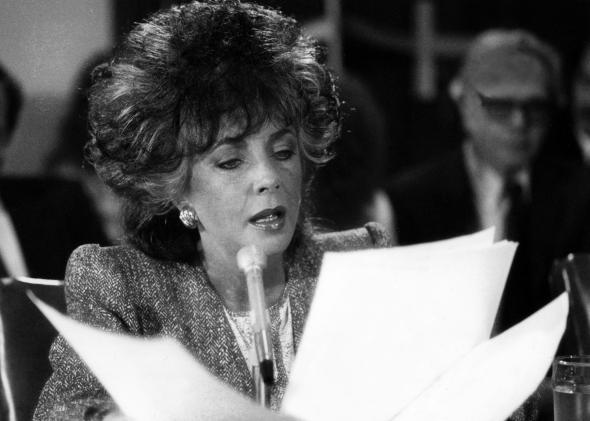As yet another World AIDS Day passes, HBO brings to the screen another documentary about HIV/AIDS. Produced by fashion designer Kenneth Cole, The Battle of amfAR, which premieres Monday, Dec. 2, is in a minor key compared with deep, rich offerings such as 2012’s Oscar-nominated How to Survive a Plague (coming to PBS at the end of the year) and the legendary And the Band Played On. If you need schooling on how HIV/AIDS took hold, and on the long and often maddening battle to bring the disease to heel and the public to action, start with those two canonical works. But this little film is worth your time, too.
Cole, who’s also the chairman of amfAR’s board, wanted to shine a harsh spotlight on how society’s fear, and the need to believe that HIV infection wasn’t a real threat to anyone but oversexed gay men and the occasional hemophiliac, impeded research and public education. To those ends, the film enlists a major star: Elizabeth Taylor. Along with the story of amfAR co-founder Mathilde Krim, Taylor’s involvement in the early days of the AIDS crisis drives the narrative of The Battle of amfAR.
Even before her “dear friend” Rock Hudson got sick and died of AIDS, Taylor put herself out there on an issue that frightened and disgusted most people. The film starts with the beautiful Taylor showing her earthy side at a press conference. There had been a “huge, loud silence” about AIDS, she said. “And I finally thought, ‘Bitch, do something yourself.’ ” As Taylor makes clear, she didn’t much like her celebrity—except in this case. As she put it, “There are times when being famous is useful; it comes in handy.”
The film isn’t clear about how amfAR formed from the merger of two early AIDS organizations, the New York-based AIDS Medical Foundation (of which Krim was a co-founder) and the Los Angeles-centered National AIDS Research Foundation, co-founded by Taylor. Both organizations were suffering from the lack of federal research support, and Krim understood that merging the two groups—especially with a money-magnet like Taylor as the public face of the combined effort—might draw the funding needed to do the basic research that was lacking. So Krim picked up the phone and called her. As Krim recounts the conversation (with a smile), “She almost immediately said yes. So we started amfAR.”
As Krim’s nervy phone call shows, she does two things quite well: She’s a sharp scientist—who also has an eye on the need to engage and enlist high-powered support for the cause. Galvanized in her youth by scenes from the liberation of World War II concentration camps—and by her parents’ willful ignorance of the human cataclysm—Krim decided that only science could “replace all these stupidities with facts, with real knowledge.” When AIDS erupted, she turned her research in virology toward solving the problem.
But her celebrity connections are no less important to the story; these were established long before the AIDS crisis because of her marriage to media mogul and Democratic insider Arthur Krim. (Indeed, the well-known JFK 45th birthday party in 1962 was held at the Krims’ New York City home.) When she saw the benefit of a merger, she was ready to pounce. Thus was born amfAR, described in the film as involved in every important advance in AIDS research and still active today.
It wasn’t easy in the beginning. amfAR received bags of hate mail, venom that was intended for Rock Hudson or for “homosexuals” more generally. For those who haven’t lived with HIV’s long history, it’s hard to understand why an organization trying to gather money for research would be on the receiving end of this crap. So the directors, Rob Epstein and Jeffrey Friedman, provide further context by zeroing in on then-President Ronald Reagan’s shameful response to the crisis. Reminding viewers of Reagan’s complete lack of leadership on AIDS is a helpful corrective to hagiographic depictions of the Gipper. I cringed, again, hearing “the Great Communicator” linguistically and morally fumble his answer to a question about whether he’d allow one of his children to attend a school with someone infected with HIV: “I’m glad I’m not faced with that problem today. I can well understand the plight of the parents. And yet medicine has not come forth unequivocally and said: ‘This we know for a fact. That it is safe.’ ” Many have blamed Reagan for deaths that earlier leadership might have prevented; watching this, it’s easy to see why.
Krim is succinct about this president’s clanging silence: “Reagan was miserable.” (He wasn’t the only governmental actor causing damage, either. In 1986, the Supreme Court handed down its gay-bashing decision in Bowers v. Hardwick, upholding a Georgia law that criminalized even private intimacy between gays and lesbians.)
While Reagan was barricading himself from knowledge or experience with anything that might have shaken his simple worldview, Taylor and Krim dove in. One of the film’s most touching moments comes in hearing about how Taylor, wanting to support unpopular needle-exchange efforts, visited one such program and told the most marginalized women that they could be beautiful. (She also refers to the government’s failure to support these programs “an act of premeditated murder.” Sometimes it helps to be a real drama queen.) Krim, for her part, became best buds with New York’s Mr. Leather after riding with him on a Gay Pride parade float. She laughs sympathetically about the education she received from gay men about their sexual practices.
Relative to the obstacles her efforts encountered, Krim faced long odds. That she figured out how to leverage the influence she had to effect real progress speaks to a kind of sustaining optimism. The film ends on that note, with Krim’s exhortation to people who feel they can’t make a difference. To those who think “I’m just a little guy; I can’t have an effect on public policy,” Krim offers this admonishment: “It’s not so, you know. Everybody can do something.”
